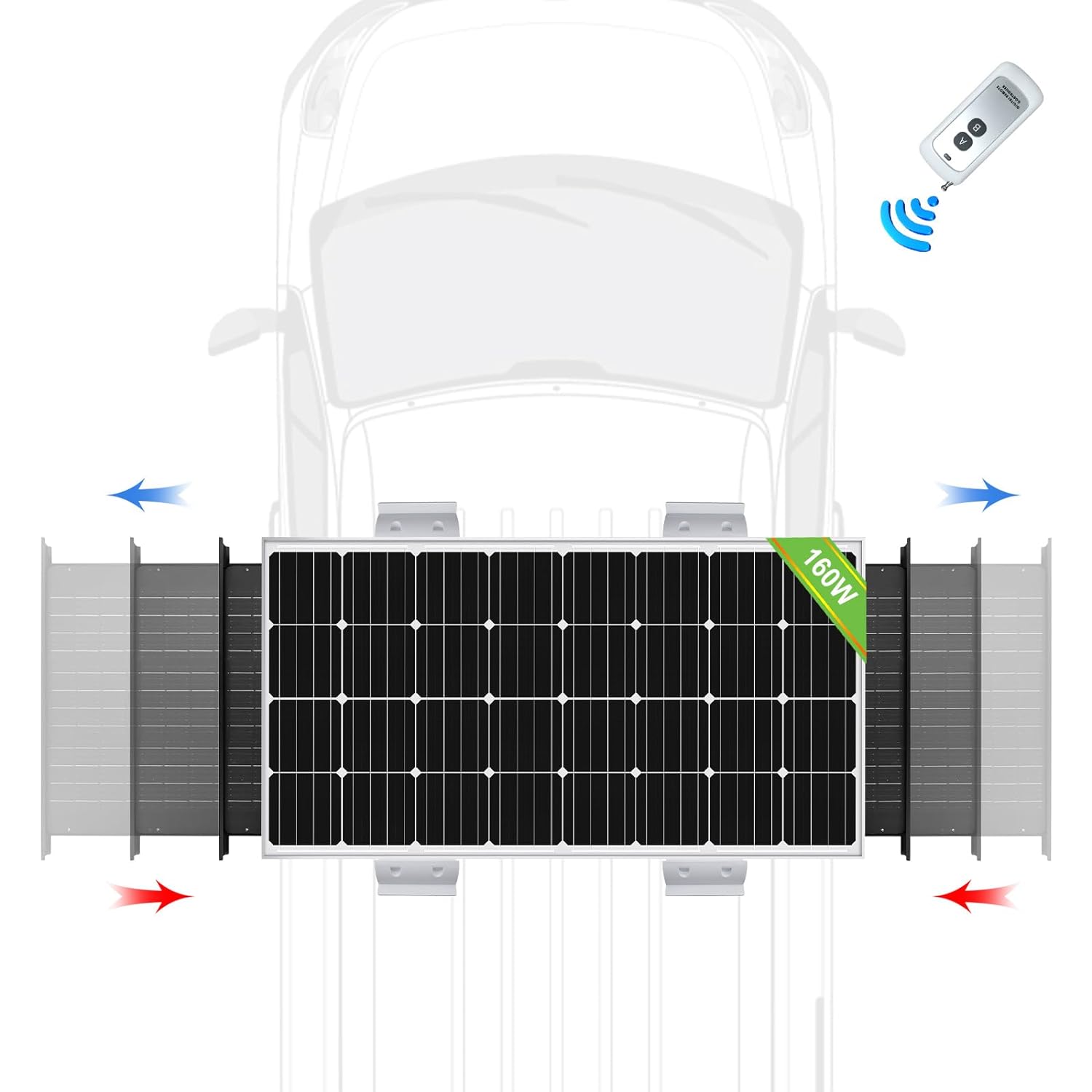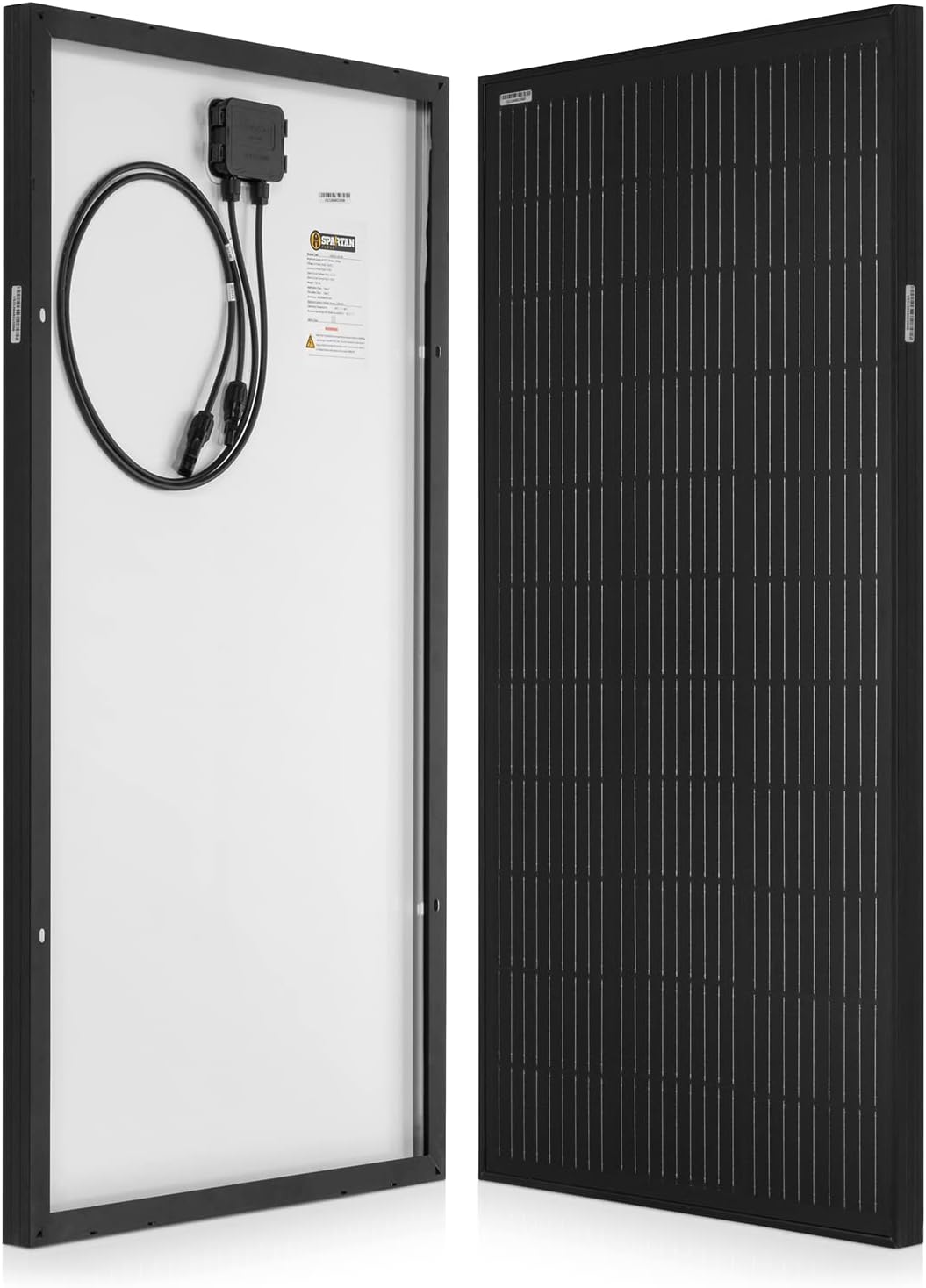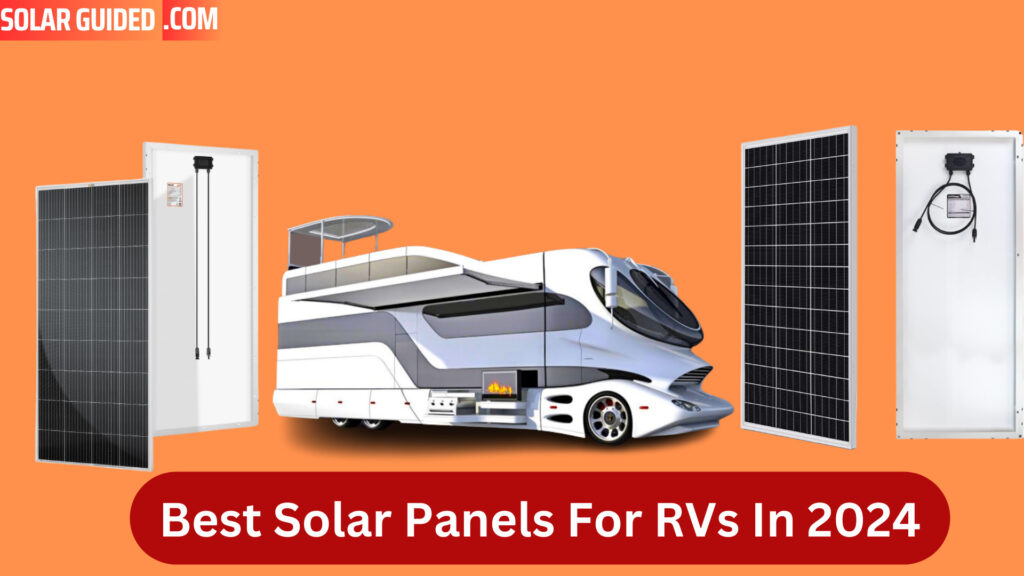
Best Solar Panels For RV In 2024
Greetings, I’m Afaq, and I’m genuinely excited to explore the world of RV solar power with you guys especially those who are not too experienced in this field and need my guidance. As we step into 2024, we’re presented with some remarkable solar options to elevate your RV adventures.
Whether you’re a seasoned traveler or you just want to do it for the very first time and start your RV journey, the idea of powering your RV with solar panels is one of the best because on RV you will have no other options than solar panels to get power or electricity so it’s the one and only best option for everyone.
For Installing and finding a good solar panel for your RV it’s necessary to search beforehand and take guidance because later you can face problems with installation because that is one of the complicated processes.
I’m here as your trusted companion, ready to provide an effortless guide to the finest solar panels for your RV and share precisely why they’re the cream of the crop. If you’re ready to save on costs, embrace eco-friendliness, and savor a hassle-free RV experience, then make sure to understand our complete guide and read it.
What Are RV Vehicles?
RVs, or Recreational Vehicles, are motor vehicles or trailers that are designed for living and sleeping accommodations while traveling, camping, or on extended road trips. RVs, or Recreational Vehicles, are like traveling homes for your adventures. They come in different shapes and sizes, offering comfy living and sleeping spaces while you’re on the go, whether it’s for a road trip or camping. RVs are like little houses on wheels, packed with everything you need to enjoy your journey.
Total Power/Wattage Usage For RVs:
| Appliance | Power Consumption (W or kW) | Total Solar Panel Wattage Required (W) |
|---|---|---|
| Microwave (900W) | 900 – 1,500 W | 1,500 – 2,500 W |
| Electric Heater (1,500W) | 1,500 W | 2,500 W |
| Refrigerator (12V or 120V) | 100 – 800 W | 200 – 1,500 W |
| LED Lights (per bulb) | 5 – 15 W | Varies based on the number of bulbs |
| Water Pump (12V) | 5 – 10 W | 10 – 20 W |
| Vent Fan (12V) | 10 – 50 W | 20 – 100 W |
| Laptop | 30 – 100 W | 50 – 200 W |
| TV (LED) | 30 – 150 W | 50 – 250 W |
| Coffee Maker | 600 – 1,200 W | 1,000 – 2,000 W |
| Toaster | 800 – 1,500 W | 1,500 – 3,000 W |
| Hair Dryer | 1,200 – 1,800 W | 2,000 – 3,500 W |
| Electric Stove (per burner) | 1,000 – 1,800 W | 2,000 – 3,500 W |
| Battery Charger (12V) | 50 – 100 W | 100 – 200 W |
Note: 1 kW = 1,000 W
Total Solar Panel Wattage Required is an estimate based on typical daily usage. It’s advisable to install additional panels to account for variations in sunlight and energy consumption.
This table provides estimates of the power consumption and the total solar panel wattage required for various RV appliances, excluding the air conditioner. Please remember that actual power usage may vary depending on specific models and usage patterns, and it’s essential to consider your location and the number of hours of sunlight you receive when planning your solar panel setup.
Total Wattage Solar Panels Required For The Above Power Usage:
200 Watt – 500 Watt (if you use each of the appliances for 2 hours each day and you get 5 hours of sunlight).
There are four main types of RVs:
1. Motorhomes:

These are the RVs that drive themselves, like magic houses on wheels. They come in three classes, from the big and fancy Class A motorhomes to the smaller Class B and Class C options. Motorhomes are self-contained recreational vehicles (RVs) equipped with living accommodations, such as sleeping areas, kitchens, and bathrooms. They come in three primary classes:
- Class A Motorhomes
- Class B Motorhomes (Camper Vans)
- Class C Motorhomes
Recommended Solar Panel For Motorhomes:
ECO-WORTHY Bifacial 195 Watt 12 Volt Solar Panel Monocrystalline
This solar panel is used for RV vehicles, it has a transparent back of 12BB solar cells. Its back panel is made up of composite materials rate of light transmittance is approximately 91.5%, and it has a 23% energy conversion rate. It can generate 858Wh power per day under ideal conditions and energy surge up to 33%. Its weight is 20.48 Lbs, this solar panel is windproof and snow-resistant. I will recommend this solar panel because it works in any condition and weather i.e. rainy, stormy, windy, sunny, etc. It will not corrode with water and it is very fast in energy conversion. 195 watts is enough for charging your gadgets and using electronic appliances.
Installing Solar Panel On MotorHomes:
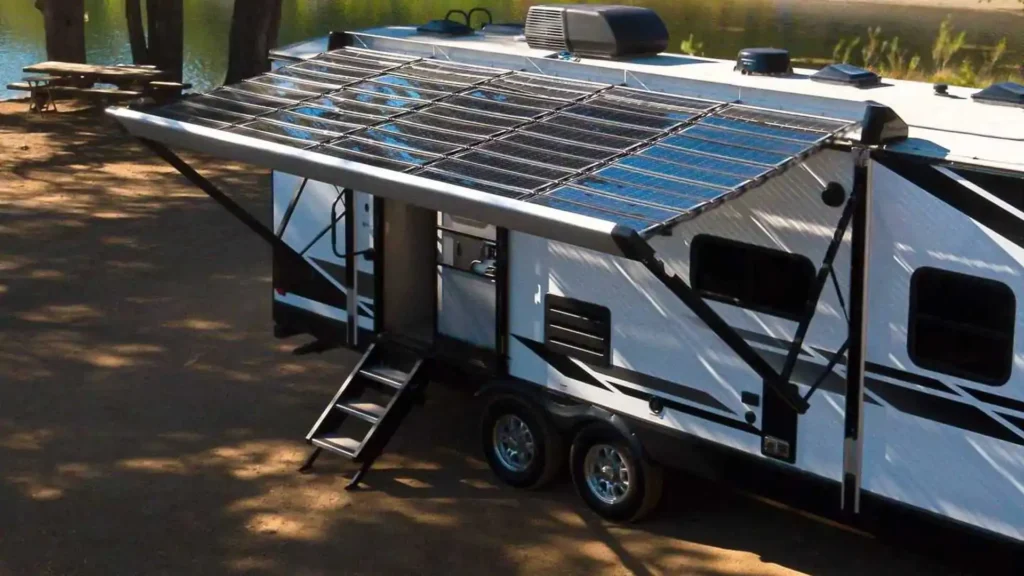
You can put solar panels on your motorhome in two ways:
Option 1: On the Roof:
- This is the most common way. You attach the solar panels directly to the roof using special brackets.
- It’s simple and doesn’t need extra equipment.
Option 2: On the Side with a Rack:
- Or, you can put solar panels on the side of your motorhome using a special frame called a “solar panel mounting rack.”
- This lets you tilt the panels to catch more sunlight, which can be useful in shady spots.
- The mounting rack is like a separate framework for the panels, placed on the side of your motorhome.
Both ways work, but roof installation is easier, while the side with a rack gives you more control over how the panels face the sun.
1. Assess Your Power Needs:
- Create a list of the appliances and devices you plan to use in your motorhome. Here are some examples and their approximate power requirements:
- LED lights (5-20 watts each)
- Refrigerator (100-800 watts depending on size and type)
- TV (50-400 watts)
- Laptop (50-100 watts)
- Water pump (50-100 watts)
- Ventilation fan (20-50 watts)
- Figure out how much power each item uses and how many hours you’ll use them in a day.
- Add up the total power needed in a day (e.g., 1,000 watts, or 1 kWh).
2. Pick the Right Solar Panels:
- If you need 1 kWh of power daily, you might choose two 100-watt solar panels (totaling 200 watts) to generate that electricity.
3. Locate the Ideal Installation Spot:
- Examine your motorhome’s roof to find the best location for the solar panels. For example, you might choose a spot free from obstructions like air conditioning units and with a clear view of the sun’s path throughout the day.
4. Gather Necessary Equipment:
- Collect the following components:
- Solar panels (e.g., two 100-watt panels for a total of 200 watts)
- Mounting brackets or racks designed for RV use
- Charge controller (e.g., a 20-amp MPPT charge controller)
- Inverter (if you want to run AC appliances)
- Solar panel wiring (usually provided with the panels)
- Battery wiring (with appropriate connectors)
- Fuses or circuit breakers for safety
- Sealant and adhesive for waterproofing
5. Install the Panels:
- Attach the two 100-watt solar panels to your roof with the brackets. Make sure they face the sun.
- Connect the wires from the panels to the charge controller. If each panel has two wires (plus and minus), attach the plus wires to the charge controller’s plus terminal and the minus wires to the minus terminal.
- Link the charge controller to your motorhome’s batteries using special wires.
6. Inverter (Optional):
- If you want to use regular household devices like a TV or laptop charger, add an inverter. Connect it to your batteries.
7. Keep an Eye on Things:
- Keep Checking your solar panels for damage and dirt, and regularly clean it to keep it efficient.
- Use the charge controller’s display or a separate monitor to see how your batteries are doing and how much power you’re making.
2. Travel Trailers:
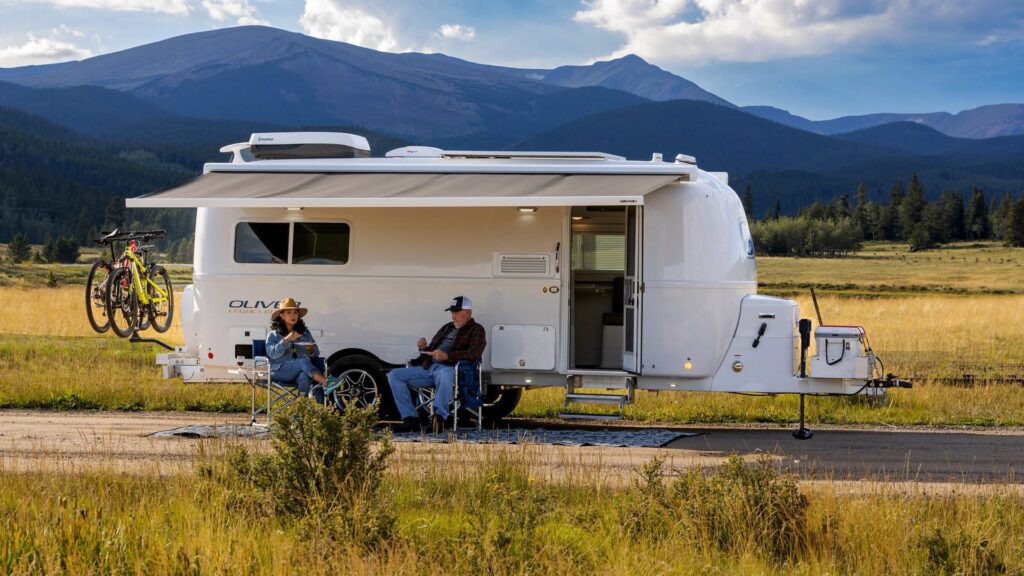
Travel Trailers are like cozy, portable homes you can tow behind your car or truck. They come in different sizes and styles, from compact models to larger, more comfortable ones. Inside, you can find everything you need for a comfy stay, like a kitchen, bathroom, and sleeping area. They’re a favorite choice for camping and road trips because they offer the freedom to go wherever you like while bringing your home with you.
These RVs don’t have engines of their own; instead, you tow them behind your vehicle, like a trusty sidekick. There are different types, like regular travel trailers, fifth-wheel trailers that hitch to the bed of your truck, and pop-up campers that can expand to create more space. They come in various sizes and layouts to suit your preferences.
Recommended Solar Panel For Travel Trailers
Newpowa 220W Monocrystalline Solar Panel 10BB Cell Solar Panel 220 Watt 12V High Efficiency
Why this Newpowa 220W is the Best Solar Panel For Travel Trailers?
These are 220 Watts panels having 56.69*30.12*1.38inch dimensions. these panels are like solar superheroes, soaking up the sun’s rays efficiently. Monocrystalline cells are known for their energy-converting skill and they provide 21% higher efficiency than Polycrystalline.
I recommend these solar panels for Travel Trailers because they are long-lasting and contain Monocrystalline cells which help in efficiency and energy conversion. 220 Watts is enough for charging your devices and using other electrical appliances. It withstands all types of weather i.e. rainy, windy, cloudy, sunny, etc.
Installing Solar Panels On Travel Trailers:
The Installation Process of Solar Panels on Travel Trailers is almost the same as the Above MotorHomes but here I will describe it for you.
1. Assess Your Needs:
First, figure out what you want to power with your solar panels. This might include lights, a fridge, or charging your gadgets. Calculate how much power you need each day.
2. Choose Solar Panels:
Pick solar panels that can generate enough power to meet your daily needs. Consider lightweight and efficient monocrystalline panels.
3. Find a Good Spot:
Locate a sunny spot on your travel trailer’s roof. Make sure it’s free from obstructions like vents or air conditioning units.
4. Gather Equipment:
Get the gear you need: solar panels, special brackets, a charge controller, wiring, connectors, and fuses. If you want to use regular household devices, you’ll also need an inverter.
5. Install the Panels:
Securely attach the solar panels to the roof using the brackets. Tilt them to catch the most sunlight. Some trailers have tilt kits to help you do this easily.
6. Connect the Wiring:
Wire the panels to a charge controller to manage the power and prevent overcharging your batteries. Connect the charge controller to your trailer’s battery.
7. Optional Inverter:
If you plan to use regular household devices, connect an inverter to your battery. This converts the power so you can use gadgets that plug into wall outlets.
8. Monitor and Maintain:
Regularly check your solar panels for dirt or damage. Clean them with mild detergent and water. If you have a monitoring system, use it to keep an eye on your power production.
3. Folding or Pop-Up Campers:
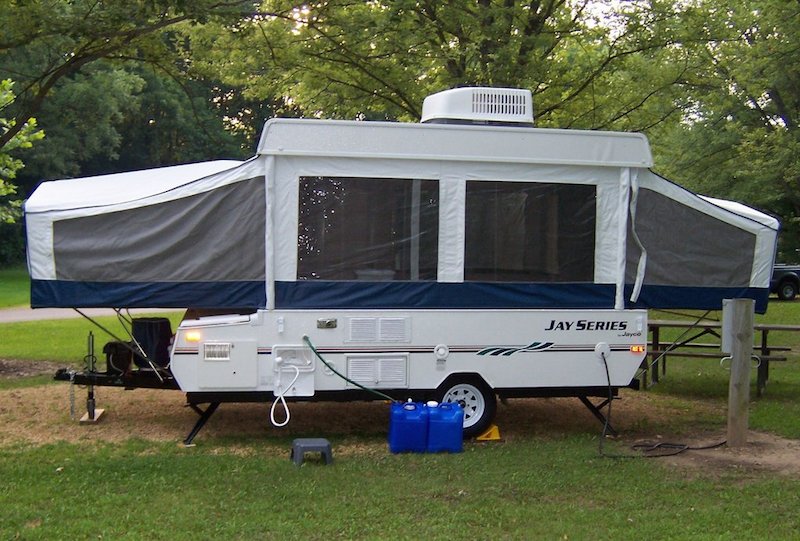
Folding or Pop-Up Campers are like magic tents on wheels. They start as a compact trailer you can easily tow with your car. But when you set up camp, they pop up and become a cozy, small RV with beds and a kitchen. They’re perfect for campers who want comfort but don’t want a big, heavy RV.
Think of these as the transformers of the RV world. They start small and compact for easy towing but can unfold into larger living spaces when you park them. Some even have canvas walls to give you that camping-in-nature feeling.
Recommended Solar Panel For Folding or Pop-Up Campers:
Spartan Power 100 Watt Solar Panel 9 Bus Bar
Why This Spartan Power 100W Solar Panel Is The Best Solar Panel For Folding or Pop-Up Campers?
Spartan Power 100 Watt Solar Panel is an efficient solar panel because it has 9 BB instead of 5 BB, 9 BB helps the solar panels to transfer more electricity. These solar panels are compatible with z brackets. I will recommend Spartan Power 100 Watt 9 Bus Bar Solar Panel because it is a very efficient solar panel, it can produce more power or electricity in less-than-ideal lighting conditions. It is easy to fix these panels and these panels are quite cheap as compared to other panels.
Solar Panel Installation Process On Folding or Pop-Up Campers:
1. Power Needs:
Start by listing what you want to power with solar, like lights, a cooler, or your gadgets. Estimate how much power you’ll use daily.
2. Solar Panels:
Choose lightweight solar panels that can generate enough power for your needs. Look for monocrystalline panels for efficiency.
3. Sunny Spot:
Find a sunny spot near your camper where you can set up the solar panels. Make sure it’s not shaded by trees or other obstacles.
4. Gear Checklist:
Gather what you need: solar panels, brackets or portable stands, a charge controller, wiring, connectors, and fuses. If you want to run regular household devices, add an inverter to the list.
5. Panel Placement:
Mount the solar panels on the camper’s roof using brackets or set them up on portable stands on the ground. Angle them toward the sun for the best exposure.
6. Wiring Setup:
Connect the panels to a charge controller. Make sure the wiring is correct (positive to positive, negative to negative). Then, link the charge controller to your camper’s battery.
7. Inverter (Optional):
If you want to use regular household devices, connect an inverter to your camper’s battery. It changes the power so you can use devices that plug into wall outlets.
8. Check and Clean:
Regularly inspect your solar panels for dirt or damage. Clean them with mild detergent and water. If you have a monitoring system, use it to keep track of your power production.
4. Truck Campers:
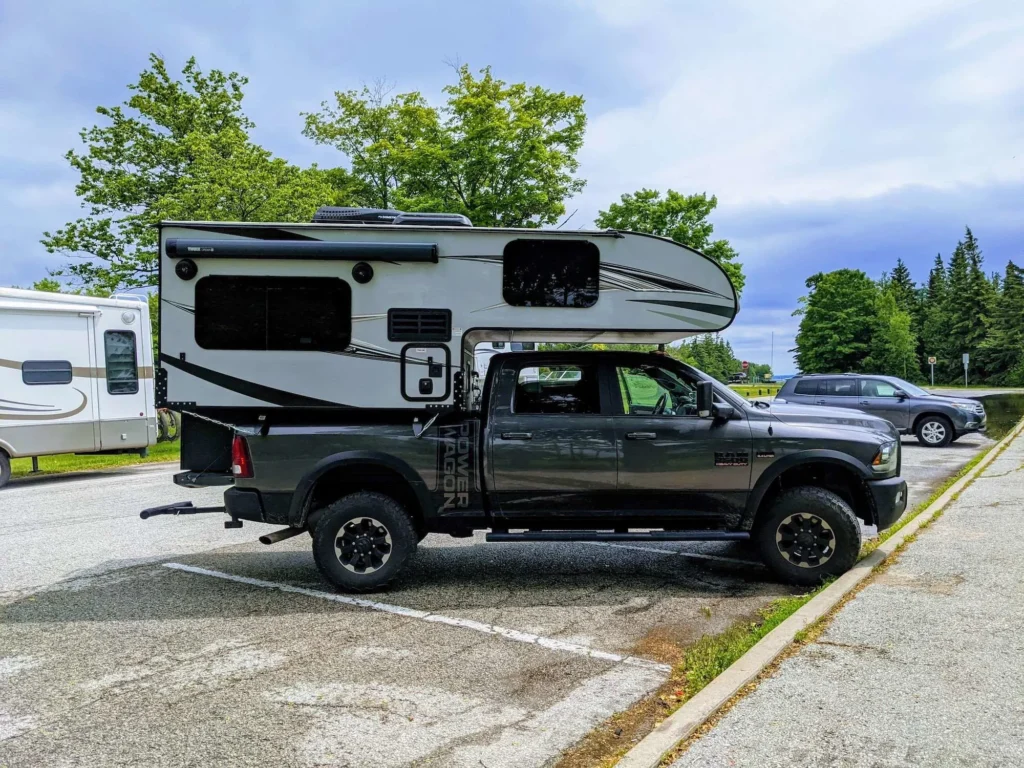
Truck Campers are like tiny, cozy homes that fit in the back of your pickup truck. They’re perfect for adventure seekers who want to travel light and go wherever their truck can take them. These campers have everything you need for a comfortable stay, like a small kitchen, a bed, and sometimes even a bathroom. Plus, when you’re not camping, you can simply detach the camper and use your truck as usual. It’s all about convenience and freedom for your outdoor adventures!
These are like cozy cabins that sit in the bed of your pickup truck. They’re small but self-contained, and you can take them off when you need to use your truck for other things.
Recommended Solar Panel For Truck Campers:
RICH SOLAR 200 Watt 12 Volt 9BB Cell Monocrystalline Solar Panel
Why This RICH SOLAR 200 Watt 12 Volt 9BB Is The Best Solar Panel For Truck Campers?
As I said already truck campers are the most compact and easy-to-assemble travel home for you, if you own a truck you should only consider a Truck Camper, but for that, we will also need a good solar panel to provide power to our appliances and other electrical items like TV, Refrigerator, etc.
For Truck Campers I will Recommend this Rich Solar panel which is exactly a 200 Watt Solar Panel, comes with a 12 Volt 9BB which means it’s efficient enough and has good potential to provide you the power even when the weather conditions are stable, if the car is moving still this solar panel will be catching enough sunlight to get power, that is why this solar panel is recommended by me to all of the truck camper owners who are traveling across their country but are lacking on power.
This solar panel is extremely light-weight and it’s very uncomplicated, it’s just a simple solar glass with a couple of wires which you are going to fit into the spot easily, and the main thing is that you can fit this solar panel over your truck camper so perfectly that you won’t even feel it over your car even you are going offroad.
Benefits of Truck Campers: Your All-in-One Adventure Companion
1. Easy Installation:
Truck campers are incredibly easy to install. Just load them onto the bed of your pickup truck, secure them in place, and you’re ready to hit the road. No need for complex hitching or towing setups.
2. No Need to Remove and Replace:
Unlike towable RVs that require detachment when you reach your destination, truck campers stay put. Once loaded onto your truck, they’re always ready for use. No hassle of disconnecting and reconnecting.
Compact and Versatile:
These campers are compact and can fit a wide range of pickup truck models. Whether you have a compact or full-sized truck, there’s likely a truck camper that can fit snugly on the bed.
4. Perfect for Off-Road Adventures:
Truck campers are built for adventure. They’re rugged and capable of handling off-road terrain, allowing you to explore remote and rugged locations with ease.
In essence, truck campers are your go-to choice for a hassle-free, compact, and versatile camping experience. They offer the convenience of a comfortable home on wheels without the need for towing, making them an excellent option for off-road enthusiasts and those seeking a more straightforward RV setup.
Installing a Truck Camper: Easy as 1-2-3
- Pick Your Spot: Find a level area to park your pickup truck. Make sure you have enough space to load the camper without any obstacles.
- Load the Camper: Slowly back your pickup truck towards the camper. Align the camper with the truck bed, making sure it’s centered. Lower the camper onto the truck bed using the built-in jacks or a separate lifting system if you have one.
- Secure It: Once the camper is in place, secure it tightly to the truck bed using the provided clamps or tie-downs. Double-check that everything is fastened securely to ensure a safe and stable ride.
That’s it! You’re now ready to hit the road with your truck camper
Installing Solar Panels on Your Truck Camper: A Breezy Process
1. Plan Your Setup:
Start by deciding where you want to place your solar panels. The camper’s roof is a common spot, but you can also consider portable panels that you can set up on the ground.
2. Choose Your Panels:
Select lightweight and efficient solar panels that can generate enough power for your needs. Monocrystalline panels are a great choice.
3. Mounting or Placement:
If you’re installing them on the roof, use mounting brackets designed for campers. Attach the solar panels securely to the roof. If you’re using portable panels, set them up in a sunny spot near your camper.
4. Wiring Connections:
Connect the solar panels to a charge controller. Make sure the wiring is correctly connected (positive to positive, negative to negative). Then, link the charge controller to your camper’s battery.
5. Inverter Setup (Optional):
If you plan to use regular household devices, connect an inverter to your camper’s battery. This device converts the power so you can use gadgets that plug into wall outlets.
6. Monitor and Maintain:
Regularly inspect your solar panels for dirt or damage. Clean them with mild detergent and water. Some campers come with monitoring systems, which can help you keep an eye on your power production.
Conclusion Of The Article:
So as you know we have brought you a complete guide on “Best Solar Panels For RV (recreational vehicles)” We have detailed everything to you simply so it’s easy for you to choose your solar panel. We have also provided the solar panels specifically best for each type of RV which will help you choose the solar panel that is best for the RV you are having.
This guide is written with pure enthusiasm and accurate knowledge make sure you don’t doubt it, and you can trust our recommendations because we have quite a good experience in installing solar panels on RVs.
